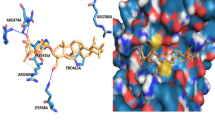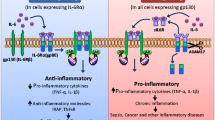Abstract
Purpose
Suppressor of cytokine signaling 7 (SOCS7) is a member of the SOCS family and is known to interact with phospholipase Cγ-1 (PLCγ-1), one of the insulin-like growth factor-I (IGF-I) receptor downstream molecules. In this study, we sought to observe the effect of knocking down SOCS7 gene on breast cancer cells in vitro growth and migration and to elucidate whether this involves IGF-I-PLCγ1 route using the PLCγ-1 blocker U73122.
Methods
Suitable breast cancer cells (MCF7 and MDA-MB-231) were transfected with anti-SOCS7 ribozymal transgene, to create sub-lines with SOCS7 knockdown verified by RT-PCR. The growth and migration of the cells were evaluated in the presence or absence of IGF-I and PLCγ-1 inhibitor using growth assay, scratch-wound and electrical cell impedance sensing (ECIS) migration assays.
Results
IGF-I treatment produced more pronounced influence on MCF7 growth and migration and on MDA-MB-231 migration when SOCS7 gene was knocked down in both lines (p < 0.05). The absence of IGF-I-induced growth response in MDA-MB-231 could be due to the intrinsic characteristics of these cells. PLCγ-1 pharmacological inhibition during their in vitro migration seemed to only occur when SOCS7 gene was knocked down.
Conclusions
To the best of our knowledge, this is the first report of the SOCS7 regulatory role in IGF-I induced in vitro functions in ER-positive and ER-negative breast cancer cells. IGF-I treatment and SOCS7 loss have synergistically resulted in increased growth and migration of MCF7 and in increased migration of MDA-MB-231 cells. The migratory effects could be due to a precise anti-PLCγ-1 role.






Similar content being viewed by others
References
Backer JM, Myers MG, Shoelson SE, Chin DJ, Sun XJ, Miralpeix M, et al. Phosphatidylinositol 3′-kinase is activated by association with IRS-1 during insulin stimulation. EMBO J. 1992;11:3469–79.
White MF. The IRS-signalling system: a network of docking proteins that mediate insulin action. Mol Cell Biochem. 1998;182:3–11.
Bornfeldt KE, Raines EW, Nakano T, Graves LM, Krebs EG, Ross R. Insulin-like growth factor-I and platelet-derived growth factor-BB induce directed migration of human arterial smooth muscle cells via signaling pathways that are distinct from those of proliferation. J Clin Investig. 1994;93:1266–74.
Abedi H, Zachary I. Vascular endothelial growth factor stimulates tyrosine phosphorylation and recruitment to new focal adhesions of focal adhesion kinase and paxillin in endothelial cells. J Biol Chem. 1997;272:15442–51.
Wells A, Grandis JR. Phospholipase C-gamma1 in tumor progression. Clin Exp Metastasis. 2003;20:285–90.
Arteaga CL, Johnson MD, Todderud G, Coffey RJ, Carpenter G, Page DL. Elevated content of the tyrosine kinase substrate phospholipase C-gamma 1 in primary human breast carcinomas. Proc Natl Acad Sci USA. 1991;88:10435–9.
Pollak M, Beamer W, Zhang JC. Insulin-like growth factors and prostate cancer. Cancer Metastasis Rev. 1998;17:383–90.
Kassis J, Moellinger J, Lo H, Greenberg NM, Kim HG, Wells A. A role for phospholipase C-gamma-mediated signaling in tumor cell invasion. Clin Cancer Res. 1999;5:2251–60.
Wauman J, De Smet AS, Catteeuw D, Belsham D, Tavernier J. Insulin receptor substrate 4 couples the leptin receptor to multiple signaling pathways. Mol Endocrinol. 2008;22:965–77.
Pazienza V, Vinciguerra M, Andriulli A, Mangia A. Hepatitis C virus core protein genotype 3a increases SOCS-7 expression through PPAR-{gamma} in Huh-7 cells. J Gen Virol. 2010;91:1678–86.
Rui L, Yuan M, Frantz D, Shoelson S, White MF. SOCS-1 and SOCS-3 block insulin signaling by ubiquitin-mediated degradation of IRS1 and IRS2. J Biol Chem. 2002;277:42394–8.
Krebs DL, Uren RT, Metcalf D, Rakar S, Zhang JG, Starr R, et al. SOCS-6 binds to insulin receptor substrate 4, and mice lacking the SOCS-6 gene exhibit mild growth retardation. Mol Cell Biol. 2002;22:4567–78.
Kremer BE, Adang LA, Macara IG. Septins regulate actin organization and cell-cycle arrest through nuclear accumulation of NCK mediated by SOCS7. Cell. 2007;130:837–50.
Matuoka K, Miki H, Takahashi K, Takenawa T. A novel ligand for an SH3 domain of the adaptor protein Nck bears an SH2 domain and nuclear signaling motifs. Biochem Biophys Res Commun. 1997;239:488–92.
Nishimura R, Li W, Kashishian A, Mondino A, Zhou M, Cooper J, et al. Two signaling molecules share a phosphotyrosine-containing binding site in the platelet-derived growth factor receptor. Mol Cell Biol. 1993;13:6889–96.
Lettau M, Pieper J, Janssen O. Nck adapter proteins: functional versatility in T cells. Cell Commun Signal. 2009;7:1.
Lee CH, Li W, Nishimura R, Zhou M, Batzer AG, Myers MG Jr, et al. Nck associates with the SH2 domain-docking protein IRS-1 in insulin-stimulated cells. Proc Natl Acad Sci USA. 1993;90:11713–7.
Amoui M, Craddock BP, Miller WT. Differential phosphorylation of IRS-1 by insulin and insulin-like growth factor I receptors in Chinese hamster ovary cells. J Endocrinol. 2001;171:153–62.
Hu Q, Milfay D, Williams LT. Binding of NCK to SOS and activation of ras-dependent gene expression. Mol Cell Biol. 1995;15:1169–74.
Knisz J, Banks A, McKeag L, Metcalfe DD, Rothman PB, Brown JM. Loss of SOCS7 in mice results in severe cutaneous disease and increased mast cell activation. Clin Immunol. 2009;132:277–84.
Martens N, Uzan G, Wery M, Hooghe R, Hooghe-Peters EL, Gertler A. Suppressor of cytokine signaling 7 inhibits prolactin, growth hormone, and leptin signaling by interacting with STAT5 or STAT3 and attenuating their nuclear translocation. J Biol Chem. 2005;280:13817–23.
Jiang WG, Davies G, Martin TA, Parr C, Watkins G, Mason MD, et al. Molecular targeting of matrilysin and its impact on tumour growth in vivo, the potential implications in breast cancer therapy. Clin Cancer Res. 2005;11:6012–9.
Keese CR, Wegener J, Walker SR, Giaever I. Electrical wound-healing assay for cells in vitro. Proc Natl Acad Sci USA. 2004;101:1554–9.
Pollak MN, Polychronakos C, Yousefi S, Richard M. Characterization of insulin-like growth factor I (IGF-I) receptors of human breast cancer cells. Biochem Biophys Res Commun. 1988;154:326–31.
Arteaga CL, Kitten LJ, Coronado EB, Jacobs S, Kull FC Jr, Allred DC, et al. Blockade of the type I somatomedin receptor inhibits growth of human breast cancer cells in athymic mice. J Clin Investig. 1989;84:1418–23.
Jackson JG, White MF, Yee D. Insulin receptor substrate-1 is the predominant signaling molecule activated by insulin-like growth factor-I, insulin, and interleukin-4 in estrogen receptor-positive human breast cancer cells. J Biol Chem. 1998;273:9994–10003.
Schnarr B, Strunz K, Ohsam J, Benner A, Wacker J, Mayer D. Down-regulation of insulin-like growth factor-I receptor and insulin receptor substrate-1 expression in advanced human breast cancer. Int J Cancer. 2000;89:506–13.
Surmacz E. Function of the IGF-I receptor in breast cancer. J Mammary Gland Biol Neoplasia. 2000;5:95–105.
Bartucci M, Morelli C, Mauro L, Ando S, Surmacz E. Differential insulin-like growth factor I receptor signaling and function in estrogen receptor (ER)-positive MCF-7 and ER-negative MDA-MB-231 breast cancer cells. Cancer Res. 2001;61:6747–54.
Bartella V, De Marco P, Malaguamera R, Belfiore A, Maggiolini M. New advances on the functional cross-talk between insulin like growth factor-I and estrogen signaling in cancer. Cell Signal. 2012;24:1515–21.
Conflict of interest
None.
Author information
Authors and Affiliations
Corresponding author
Rights and permissions
About this article
Cite this article
Sasi, W., Ye, L., Jiang, W.G. et al. Observations on the effects of Suppressor of Cytokine Signaling 7 (SOCS7) knockdown in breast cancer cells: their in vitro response to Insulin Like Growth Factor I (IGF-I). Clin Transl Oncol 16, 476–487 (2014). https://doi.org/10.1007/s12094-013-1107-0
Received:
Accepted:
Published:
Issue Date:
DOI: https://doi.org/10.1007/s12094-013-1107-0




